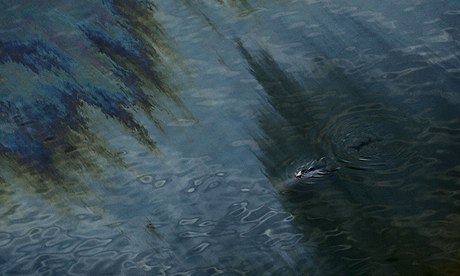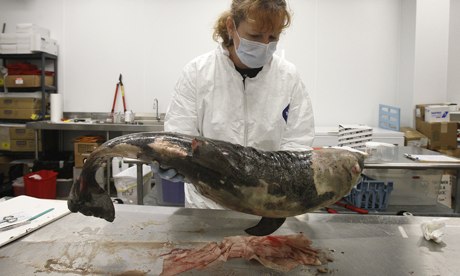Study links BP oil spill to dolphin deaths
US government scientists have for the first time found direct evidence of toxic exposure in the Gulf of Mexico

A
dolphin is seen swimming through an oil sheen from the Deepwater
Horizon oil spill off East Grand Terre Island, where the Gulf of Mexico
meets Barataria Bay, on the Louisiana coast, July 31, 2010. Photograph:
Gerald Herbert/AP
The study, led by scientists from the National Oceanic and Atmospheric Administration, found lung disease, hormonal abnormalities and other health effects among dolphins in an area heavily oiled during the BP spill.

An Institute for Marine Mammal Studies veterinary technician examines a dead bottlenose dolphin that was found on Ono Island. Photograph: Patrick Semansky/AP
The diseases found in the dolphins at Barataria Bay in Louisiana – though rare – were consistent with exposure to oil, the scientists said.
"Many disease conditions observed in Barataria Bay dolphins are uncommon but consistent with petroleum hydrocarbon exposure and toxicity," the scientists said.
Half of the dolphins were given a guarded prognosis, and 17% were expected to die of the disease, the researchers found.
"I've never seen such a high prevalence of very sick animals – and with unusual conditions such as the adrenal hormone abnormalities," Lori Schwake, the study's lead author, said in a statement.
Read More Here
.....
BP Oil Spill May Have Contributed to Dolphin Deaths, Study Finds
Stephanie Pappas, LiveScience Senior Writer | July 20, 2012 12:49pm ET
Between January and April 2011, 186 dead bottlenose dolphins washed ashore between Louisiana and western Florida. Most alarmingly, nearly half of these casualties were calves, which is more than double the usual proportion of young to old dolphins found dead. Scientists now blame both natural factors and human catastrophe for the unusual die-off.
"Unfortunately, it was a 'perfect storm' that led to the dolphin deaths," study researcher Graham Worthy, a biologist at the University of Central Florida, said in a statement. "The oil spill and cold water of 2010 had already put significant stress on their food resources. … It appears the high volumes of cold freshwater coming from snowmelt water that pushed through Mobile Bay and Mississippi Sound in 2011 was the final blow." [Gulf Oil Spill: Animals at Risk]
The winter of 2010 was a cold one, the researchers reported July 18 in the open-access journal PLoS ONE. Oil began spilling into the Gulf in April 2011, after the Deepwater Horizon platform exploded following a blowout.
The unusually harsh winter of 2010 already dealt wildlife a disadvantage, Worthy and his colleagues wrote. Finfish, marine birds, sea turtles and manatees had been hit hard, with about 6 percent of the U.S. population of manatees lost to cold weather.
Just before the baby dolphins began washing ashore in January 2011, meltwater from an unusually heavy Mobile Bay watershed snowfall hit the Gulf. A comparison of dolphin stranding sites and water conditions revealed that the discovery of the carcasses followed temperature dips from meltwater by two to three weeks, indicating that the dolphins were stressed, died, washed ashore and were eventually found and recorded.
Read More Here
.....
.....












No comments:
Post a Comment
Hello and thank you for visiting my blog. Please share your thoughts and leave a comment :)